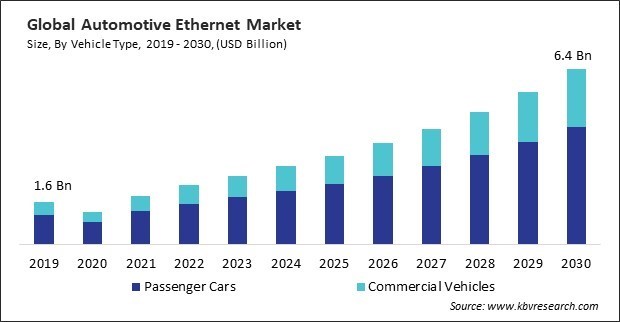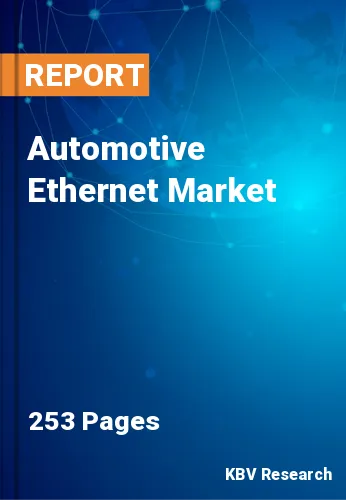“Global Automotive Ethernet Market to reach a market value of USD 6.4 Billion by 2030 growing at a CAGR of 14.2%”
The Global Automotive Ethernet Market size is expected to reach $6.4 billion by 2030, rising at a market growth of 14.2% CAGR during the forecast period.
From real-time sensor data processing to instant adjustments in suspension systems, the chassis relies on efficient communication for optimal functionality. Consequently, the chassis segment captured $210.20 million revenue in the market in 2022. The modern chassis is evolving into a hub of data-intensive applications, demanding a robust and high-speed communication network. Automotive Ethernet, with its ability to handle large volumes of data at high speeds, becomes the backbone of these applications, ensuring responsiveness and accuracy in the chassis operations. Thus, the segment will expand rapidly in the upcoming years.

The major strategies followed by the market participants are Mergers & Acquisition as the key developmental strategy to keep pace with the changing demands of end users. For instance, In July, 2023, Microchip Technology Incorporated launched LAN8670/1/2 10BASE-T1S Ethernet PHYs. The LAN8670/1/2 10BASE-T1S Ethernet PHYs are functional safety ready and make it possible to connect low-speed devices in automotive applications. Additionally, In November, 2023, Molex, LLC launched Single Pair Ethernet (SPE) technology as a new offering in its future product portfolio. This device was designed to bridge connection and control gaps in industrial networks, driving Molex's commitment to SPE as the new Ethernet paradigm.
Based on the Analysis presented in the KBV Cardinal matrix; Broadcom, Inc. is the forerunners in the Market. For Instance, In November, 2020, Broadcom Inc. launched its automotive AEC-Q100 compliant multigigabit Ethernet PHY transceiver family (BCM8989X) and multilayer Ethernet switch family (BCM8957X) with 802.1AE MACsec support. The BCM8989X is the industry's first IEEE 802.3ch standard compliant automotive 10G/5G/2.5GBASE-T1 MACsec PHY, while the BCM8957X is the first automotive L2/L3 switch with MACsec support and PHY interfaces accommodating data rates from 10 Mbps to 10 Gbps. Companies such as Microchip Technology Incorporated, NXP Semiconductors N.V., Keysight Technologies, Inc. are some of the key innovators in Market.

It offers high data transfer rates, providing the necessary bandwidth to accommodate the large volume of data generated and exchanged by diverse electronic systems in a vehicle. This is crucial for advanced driver assistance systems (ADAS), infotainment, and sensor data processing applications. With the advancement of autonomous driving in the automotive industry, electronic system complexity has increased substantially. It provides the communication infrastructure for autonomous vehicles to process and exchange data between sensors, lidar, radar, and other components essential for safe and reliable autonomous operation. Hence, these factors will lead to increased demand for automotive Ethernet.
Additionally, for applications including sophisticated driver assistance systems, parking assistance, and surround-view monitoring, the proliferation of high-definition cameras in vehicles necessitates a communication infrastructure capable of transmitting vast quantities of visual data. Its high data transmission rates enable seamless and real-time streaming of high-quality video feeds. In addition, its ability to handle large volumes of data positions it as a future-proof solution for emerging technologies. As vehicles continue to evolve with new features and functionalities, the robust data transmission capabilities of Ethernet support the integration of cutting-edge technologies. Thus, these factors will fuel the demand in the market.
Automotive architectures often comprise diverse systems and communication protocols designed to meet specific functions. The introduction of Ethernet requires a comprehensive understanding of these existing systems, making integration complex due to the inherent diversity in legacy architectures. Legacy automotive systems commonly operate on proprietary communication protocols. The integration process demands rigorous testing and validation to ensure the reliability and safety of the adapted systems. Comprehensive testing becomes complex due to the need to validate the interoperability of legacy components with newly integrated Ethernet elements, adding to the overall complexity of the transition. Therefore, these factors will decrease demand for this Ethernet in the coming years.
Based on vehicle type, the market is divided into passenger cars and commercial vehicles. The passenger cars segment recorded the maximum revenue share in the market in 2022. The segment is witnessing a surge in demand for high-quality multimedia content, streaming services, and interactive features. Ethernet's ability to handle large data volumes at high speeds ensures a smooth and immersive infotainment experience, enhancing the overall driving pleasure for passengers. Hence, these factors will lead to enhanced growth in the segment.
Based on component, the market is segmented into hardware, software, and services. In 2022, the software segment garnered a significant revenue share in the market. There are numerous electronic systems and components in contemporary automobiles, including infotainment, telematics, and advanced driver assistance systems (ADAS). The growing complexity of these in-vehicle systems necessitates sophisticated software solutions to manage, coordinate, and optimize their performance. The Ethernet, with its high data transfer capabilities, relies on advanced software algorithms to ensure the efficient functioning of these intricate systems. Therefore, the segment will expand rapidly in the upcoming years.

On the basis of application, the market is divided into chassis, infotainment, powertrain, driver assistance, body & comfort, and others. The driver assistance segment procured the maximum revenue share in the market in 2022. Driver Assistance Systems have evolved beyond basic functionalities, embracing higher complexity to offer a comprehensive suite of safety features. A robust, high-speed communication network becomes paramount as these systems incorporate more sensors, cameras, and LiDAR technologies. Therefore, these aspects will fuel the demand in the segment.
Free Valuable Insights: Global Automotive Ethernet Market size to reach USD 6.4 Billion by 2030
By region, the market is segmented into North America, Europe, Asia Pacific, and LAMEA. The Asia Pacific segment procured the highest revenue share in the market in 2022. The Asia Pacific region is a major hub for automotive manufacturing, with countries such as China, Japan, South Korea, and India being prominent players. The continuous growth in automotive production and the integration of advanced technologies in vehicles drive the demand for its solutions. Hence, these factors will lead to increased demand in the segment.
| Report Attribute | Details |
|---|---|
| Market size value in 2022 | USD 2.2 Billion |
| Market size forecast in 2030 | USD 6.4 Billion |
| Base Year | 2022 |
| Historical Period | 2019 to 2021 |
| Forecast Period | 2023 to 2030 |
| Revenue Growth Rate | CAGR of 14.2% from 2023 to 2030 |
| Number of Pages | 253 |
| Number of Tables | 373 |
| Report coverage | Market Trends, Revenue Estimation and Forecast, Segmentation Analysis, Regional and Country Breakdown, Competitive Landscape, Porter’s 5 Forces Analysis, Company Profiling, Companies Strategic Developments, SWOT Analysis, Winning Imperatives |
| Segments covered | Component, Vehicle Type, Application, Region |
| Country scope |
|
| Companies Included | Broadcom, Inc., NXP Semiconductors N.V., Marvell Technology Group Ltd., Microchip Technology Incorporated, Vector Informatik GmbH, Molex, LLC (Koch Industries, Inc.), Texas Instruments, Inc., Cadence Design Systems, Inc., Keysight Technologies, Inc., Aukua Systems Inc. |
By Vehicle Type
By Component
By Application
By Geography
This Market size is expected to reach $6.4 billion by 2030.
Increasing demand for in-vehicle connectivity are driving the Market in coming years, however, Security and cybersecurity concerns restraints the growth of the Market.
Broadcom, Inc., NXP Semiconductors N.V., Marvell Technology Group Ltd., Microchip Technology Incorporated, Vector Informatik GmbH, Molex, LLC (Koch Industries, Inc.), Texas Instruments, Inc., Cadence Design Systems, Inc., Keysight Technologies, Inc., Aukua Systems Inc.
The expected CAGR of this Market is 14.2% from 2023 to 2030.
The Hardware segment is leading the Market by Component in 2022; there by, achieving a market value of $4.2 billion by 2030.
The Asia Pacific region dominated the Market by Region in 2022, and would continue to be a dominant market till 2030; there by, achieving a market value of $2.4 billion by 2030.
Our team of dedicated experts can provide you with attractive expansion opportunities for your business.

 Drivers
Drivers
 Restraints
Restraints
 Opportunities
Opportunities
 Challenges
Challenges
